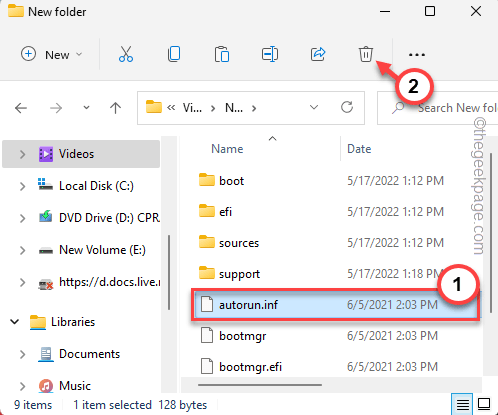

- RUFUS ISO IMAGE SCAN FAILURE HOW TO
- RUFUS ISO IMAGE SCAN FAILURE INSTALL
- RUFUS ISO IMAGE SCAN FAILURE 64 BIT
- RUFUS ISO IMAGE SCAN FAILURE DRIVERS
- RUFUS ISO IMAGE SCAN FAILURE UPDATE
RUFUS ISO IMAGE SCAN FAILURE UPDATE
You can do so by going to Settings > Update & security > Activation.Īfter having everything in order, you need to download Windows 10 64-bit ISO media and create a bootable copy. Ensure you are signed in with a Microsoft account and also ensure Windows 10 is activated. But before you can perform that, you need to first upgrade from your current 32-bit version of Windows to Windows 10 32-bit. Due to changes in how the compliance check is done for the free upgrade offer for Windows 10, Windows 10-64 bit requires a custom install. Users who want to switch from 32-bit versions of Windows to Windows 10 64-bit should be aware the migration is a multi-step process.
RUFUS ISO IMAGE SCAN FAILURE HOW TO
Learn more: How to Create a Windows 10 System Image Backup Other Considerations Some additional configuration might be required on your part, too.
RUFUS ISO IMAGE SCAN FAILURE DRIVERS
Yes, that means you will have to reinstall all your drivers and applications. There is no upgrade path from 32-bit versions of Windows to Windows 10 64-bit. Once you have gathered all the necessary prerequisites, you need to back up your personal data. If it ain’t broke, don’t try fixing it! Backup Your Computer So, you need to think this through carefully. Older applications that are 32-bit but might contain 16-bit code will not work with 64-bit Windows. For instance, if you are running applications designed for Windows XP or apps that are not fully 32-bit, you might want to reconsider your decision. Application compatibility is an important consideration.

The reason why is Windows 8, Windows 7, and Vista all share the same driver model. The manufacturer might not have native 64-bit Windows 10 drivers yet, but they might have 64-bit Windows 7 and Vista drivers that might work. After doing that, go to the manufacturer’s website and check if there are any 64-bit drivers available. The first thing to do is to create an inventory of both your hardware and software programs. Think about your other hardware such as your video card, audio device, printer, and any other critical device or application you are using? Also, if you have less than 4 GBs of RAM, I strongly suggest you stick with 32-bit Windows 10 or max out the installed RAM before migrating. Having just a 64-bit capable processor is not the main reason to go with 64-bit Windows. Learn more: What are PAE, NX, and SSE2? – Windows Help Does Your System Meet All Requirements? Most CPUs have support for these features, so it is likely because the NX feature is not enabled on your system if you receive this error.
RUFUS ISO IMAGE SCAN FAILURE INSTALL
To install Windows 10 on your PC, the processor (CPU) must support the following features: Physical Address Extension (PAE), NX, and SSE2. Please note, some older 64-bit processors might not be capable of running 64-bit Windows 10. Regardless of the ubiquity of 64-bit computing, critical factors such as hardware and application compatibility remain an issue, especially for legacy systems. If you’re running a 32-bit version of Windows, whether Windows 8 or Windows 7, you will need to consider carefully the steps to migrate from it to 64-bit Windows 8.
RUFUS ISO IMAGE SCAN FAILURE 64 BIT
If you see them, then your processor is 64 bit capable. Look for the instruction set called AMD64 or EM64T. Click the CPU tab and look in the Instructions field. You can determine if your processor is 64-bit capable by using a free tool called CPU-Z. Once you have confirmed this, you can move on to the next step. In my case, I have a 64-bit capable processor. Look under System > System type, and there it will list whether the processor is 圆4 based or not. Press Windows key + X to bring up the hidden quick access menu and select System. If you’re already running a 32-bit version of Windows 8 or later on your system, you can find out by doing the following: Switching Between 32-bit Windows 10 to 64-bit Is My Computer 64-bit Capable?īefore you can start migrating to 64-bit, you need to find out if your system is capable. Also, there is no upgrade path to move from the 64 to 32-bit version…clean install only. Also, there is no 16-bit subsystem in Windows 10 64-bit, which means your applications must be 32 or 64-bit only. You’ll need 64-bit device drivers for any hardware device. Compatibility is a critical consideration if you decide to switch to 64-bit Windows 10. You will need to back up your personal files, reinstall software applications, and reinstall hardware drivers. The entire process is a clean install only. Note: There is no in-place upgrade path from 32-bit versions of Windows to Windows 10 64-bit.


 0 kommentar(er)
0 kommentar(er)
